Examination and renovation
Crankshaft, bearings, cylinder
bores and pistons
1 Refer to Section 13 in Part A of this Chapter.
The information applies equally to the CVH engine, except that standard sized crankshafts are unmarked and the following differences in the piston rings should be noted.
2 The top rings are coated with molybdenum. https://psi-hydraulic.com dos and don for gantry lifting equipment.
Avoid damaging the coating when fitting the rings to the pistons.
3 The lower (oil control) ring must be fitted so that the manufacturer’s mark is towards the piston crown, or the groove towards the gudgeon pin. Take care that the rails of the oil control ring abut without overlapping.
Timing sprockets and belt 4 It is very rare for the teeth of the sprockets to wear, but attention should be given to the tensioner idler pulley. It must turn freely and smoothly, be ungrooved and without any shake in its bearing. Otherwise renew it.
5 Always renew the coil spring (if fitted) in the tensioner. If the engine has covered 36 000 miles (60 000 km) then it is essential that a new belt is fitted, even if the original one appears in good condition.
Flywheel
6 Refer to Section 13 in Part A of this
Chapter.
Oil pump
7 The oil pump on pre-1986 models is of gear
type incorporating a crescent shape spacer.
From 1986 onwards a low friction rotor type is fitted. Although no wear limit tolerances are specified for the gear type pump, if on inspection there is obvious wear between the gears, or signs of scoring or wear ridges, the pump should be renewed (see illustrations).
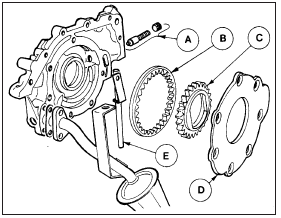
13.7a Gear type oil pump
A Pressure relief valve
B Driven gear
C Driving gear
D Oil pump cover
E Return pipe
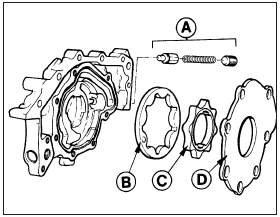
13.7b Rotor type oil pump
A Pressure relief valve
B Outer rotor
C Inner rotor
D Oil pump cover
Similarly if a high mileage engine is being reconditioned it is recommended that a new pump is fitted.
Inspection of the rotor type pump is covered in Section 13, in Part A of this Chapter.
Oil seals and gaskets
8 Renew the oil seals in the oil pump and in
the crankshaft rear oil seal retainer as a matter
of routine at time of major overhaul. It is
recommended that the new seals are drawn
into these components using a nut and bolt
and distance pieces, rather than tapping them
into position, to avoid distortion of the light
alloy castings.
9 Renew the camshaft oil seal after the camshaft has been installed.
10 Always smear the lips of a new oil seal with grease, and check that the small tensioner spring in the oil seal has not been displaced during installation.
11 Renew all gaskets by purchasing the appropriate engine set, which usually includes the necessary oil seals.
Crankcase
12 Refer to Section 13 in Part A of this Chapter.
Camshaft and bearings
13 Examine the camshaft gear and lobes for
damage or wear. If evident, a new camshaft
must be purchased, or one which has been
built-up, such as are advertised by firms
specialising in exchange components.
14 The bearing internal diameters in the cylinder head should be checked against the Specifications if a suitable gauge is available, otherwise check for movement between the camshaft journal and the bearing. If the bearings are proved to be worn, then a new cylinder head is the only answer as the bearings are machined directly in the cylinder head.
15 Check the camshaft endfloat by temporarily refitting the camshaft and thrust plate. If the endfloat exceeds the specified tolerance, renew the thrust plate.
Cam followers
16 It is seldom that the hydraulic type cam
followers (tappets) wear in their cylinder head
bores. If the bores are worn then a new
cylinder head is called for.
17 If the cam lobe contact surface shows signs of a depression or grooving, grinding out the wear surface will not only remove the hardened surface of the follower but may also reduce its overall length to a point where the self-adjusting capability of the cam follower is exceeded and valve clearances are not taken up, with consequent noisy operation.
18 Cam followers cannot be dismantled so if they become worn after high mileage, they must be renewed. On refitting, it is only necessary to smear the outside surfaces with clean engine oil, as they are self priming and will fill with engine oil once the engine is running, although initial operation may be noisy until primed.
Cylinder head and rocker arms 19 The usual reason for dismantling the cylinder head is to decarbonise and to grind in the valves. Reference should therefore be made to Section 14 in addition to the dismantling operations described here.
20 Remove the inlet and exhaust manifolds and their gaskets (Chapter 4, Part E) also the thermostat housing (Chapter 3).
21 Unscrew the nuts from the rocker arms and discard the nuts. New ones must be fitted at reassembly.
22 Remove the rocker arms and the hydraulic cam followers, keeping them in their originally fitted sequence. Keep the rocker guide and spacer plates in order.
23 The camshaft need not be withdrawn but if it is wished to do so, first remove the thrust plate and take the camshaft out from the rear of the cylinder head.
24 The valve springs should now be compressed. A standard type of compressor will normally do the job, but a forked tool (Part No 21-097) can be purchased or made up to engage on the rocker stud using a nut and distance piece to compress it.
25 Compress the valve spring and extract the split collets. Do not overcompress the spring, or the valve stem may bend. If it is found when screwing down the compressor tool that the spring retainer does not release from the collets, remove the compressor and place a piece of tubing on the retainer so that it does not impinge on the collets and place a small block of wood under the head of the valve. With the cylinder head resting flat down on the bench, strike the end of the tubing a sharp blow with a hammer. Refit the compressor and compress the spring.
26 Extract the split collets and then gently release the compressor and remove it.
27 Remove the valve spring retainer, the spring and the valve stem oil seal. Withdraw the valve.
28 Valve removal should commence with No 1 valve (nearest timing belt end). Keep the valves and their components in their originally installed order by placing them in a piece of card which has holes punched in it and numbered 1 to 8.
29 To check for wear in the valve guides, place each valve in turn in its guide so that approximately one third of its length enters the guide. Rock the valve from side to side. If any more than the slightest movement is possible, the guides will have to be reamed (working from the valve seat end) and oversize stemmed valves fitted. If you do not have the necessary reamer (Tool No 21-071 to 21-074), leave this work to your Ford dealer.
30 Examine the valve seats. Normally the seats do not deteriorate, but the valve heads are more likely to burn away, in which case new valves can be ground in as described in the next Section. If the seats require recutting, use a standard cutter, available from most accessory or tool stores.
31 Renewal of any valve seat which is cracked or beyond recutting is definitely a job for your dealer or motor engineering works.
32 If the rocker arm studs must be removed for any reason, a special procedure is necessary. Warm the upper ends of the studs with a blow-lamp flame (not a welder) before unscrewing them. Clean out the cylinder head threads with an M10 tap and clean the threads of oil or grease. Discard the old studs and fit new ones, which will be coated with adhesive compound on their threaded portion or will have a nylon locking insert. Screw in the studs without pausing, otherwise the adhesive will start to set and prevent the stud seating.
33 If the cylinder head mating surface is suspected of being distorted, it can be checked and surface ground by your dealer or motor engineering works. Distortion is possible with this type of light alloy head if the bolt tightening method is not followed exactly, or if severe overheating has taken place.
34 Check the rocker arm contact surfaces for wear. Renew the valve springs if they have been in service for 50 000 miles (80 000 km) or more.
35 Commence reassembly of the cylinder head by fitting new valve stem oil seals (see illustration).
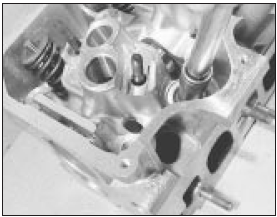
13.35 Using a socket to install a valve stem oil seal
36 Oil No 1 valve stem and insert the valve into its guide (see illustration).
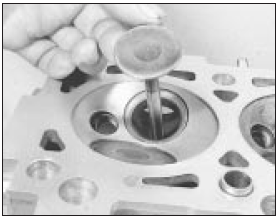
13.36 Inserting a valve into its guide
37 Fit the valve spring (closer coils to cylinder head), then the spring retainer (see illustrations).
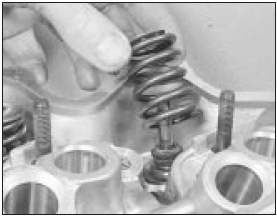
13.37a Fit the valve spring . . .
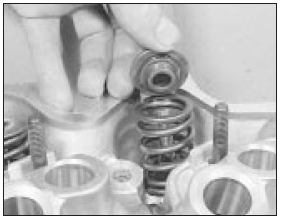
13.37b . . . and spring retainer
38 Compress the spring and engage the split collets in the cut-out in the valve stem. Hold them in position while the compressor is gently released and removed (see illustration).
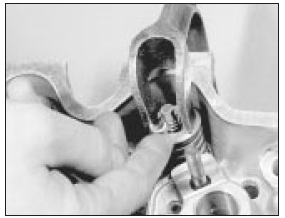
13.38 Compress the spring and fit the collets
39 Repeat the operations on the remaining valves, making sure that each valve is returned to its original guide or new valves have been fitted, into the seat into which it was ground.
40 Once all the valves have been fitted, support the ends of the cylinder head on two wooden blocks and strike the end of each valve stem with a plastic or copper-faced hammer, just a light blow to settle the components.
41 Fit the camshaft (if removed) and a new oil seal as described in Section 6.
42 Smear the hydraulic cam followers with hypoid type transmission oil and insert them into their original bores (see illustration).
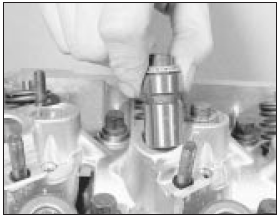
13.42 Fitting a cam follower to its bore
43 Fit the rocker arms with their guides and spacer plates, use new nuts and tighten to the specified torque. It is important that each rocker arm is installed only when its particular cam follower is at its lowest point (in contact with the cam base circle) (see illustrations).
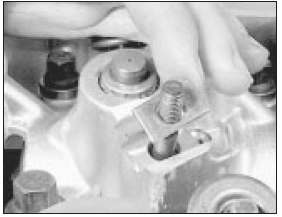
13.43a Fit the rocker arm spacer plate . . .
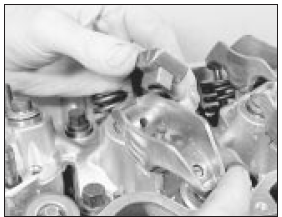
13.43b . . . followed by the rocker arm and guide
44 Refit the exhaust and inlet manifolds and the thermostat housing, using all new gaskets.
See also:
Carburettors (all types) - dismantling and reassembly
1 A complete strip-down of a carburettor is
unlikely to cure a fault which is not
immediately obvious without introducing new
problems. If persistent carburation problems
are encountered, it is re ...
Steering column lock - removal and refitting
Note: For ignition switch removal see
Chapter 5. A new shear-bolt will be
required on refitting.
Removal
1 To remove the ignition switch/column lock,
the shear-head bolt must be drilled out.
2 A ...
Heated Exhaust Gas Oxygen (HEGO) sensor - removal and refitting
Note: A new sealing ring will be required on
refitting.
Removal
1 Apply the handbrake, then jack up the front
of the vehicle and support it on axle stands
(see “Jacking and Vehicle Support”).
2 ...
